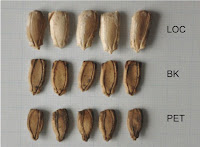Next year (2013) sees the next
International Workgroup in Palaeoethnobotany conference go to Thessaloniki Greece. Together with the overall conference organizer I am proposing a session on the role of wild foods in the Neolithic and what was special about it. This will be circulated through the regular conference channels, but to start a precis is here.
The role wild foods amongst early farmers and late foragers
(Proposal for a thematic session at IWGP 2013, Greece) By Dorian Q Fuller and Soultania Valamoti
The Neolithic transition to cultivation and reliance on domesticated grains is a major focus of archaeobotanical research, but do we have a “cereal-bias” that means we undervalue the continued roles of wild food sources amongst early farmers? Looking over archaeobotanical reports from Early Neolithic Europe or the Prepottery Near East, one often finds quite substantial quantities of remains of wild food resources, potential co-staples, or secondary staples, perhaps more than just fall back foods. The recent rise of archaeobotanical sampling in China has revealed that in the same culture in which domestication of rice is taking place the quantities of wild nut remains are vast and out- number rice. These wild foods might include nuts (Corylus or Quercus in Europe, Pistacia or Amygdalus in the Near East, Lithocarpus/Quercus, Trapa, Euryale in East Asia) or nutlets (Polygonaceae, Cyperaceae) or some small seeds (e.g. Chenopodium), as well as wild fruits. While the large quantities of these show some similarities to pre-agricultural assemblages: what has changed in their use with the advent of agriculture? There also appears to be an almost uniform contrast with later prehistory: perhaps sites of the later Neolithic or Bronze Age or Iron Age provide scant evidence for these same taxa, implying some changes since the earlier agricultural economies. Drawing largely on American evidence and Jomon Japan, Bruce Smith (2001), proposed the concept of “low-level food production“ for the first domesticators and early cultivators, in which the majority of food is inferred to come from wild sources, but despite the high levels of wild foods in the earlier Neolithic across Eurasia, it seem difficult to accept that this “low level” category necessarily applies where cereals clearly have high ubiquity and counts. The aim of this session to consider in further detail how particular sites and regional sequences inform on the role and importance of wild foods in the early Neolithic and how this may have differed from either full foraging “broad spectrum” economies or later more intensively agricultural economies. Is there a wild-side to the Neolithic that made it different from later agricultural economies? And how do we accommodate this to our understanding of the beginnings and spread of agriculture?
Paper presentations and poster presentations welcome. Please indicate your interest by emailing a provisional title to Dorian (d.fuller@ucl.ac.uk) , but also return your pre-registration form to Tania Valamoti.


















